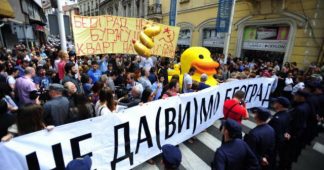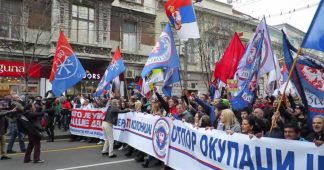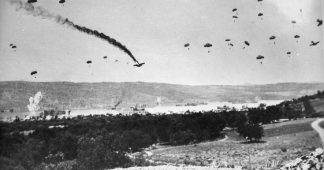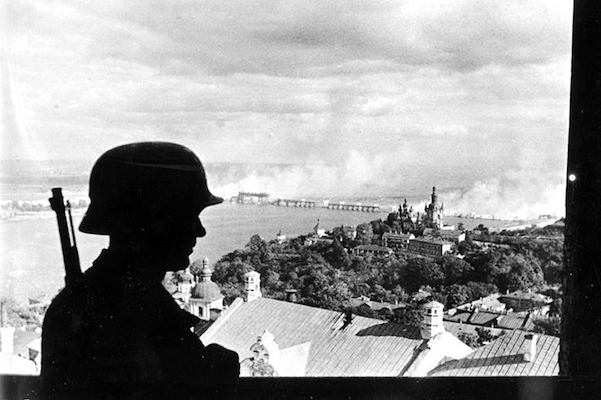April 6, 2006
By Carl Savich and Christopher Deliso
It is a dark chapter in Europe’s history, yet one that is rarely discussed: the Nazi invasion of Serbia in 1941.
Today, it is now 65 years since Hitler began the bombing of Belgrade. This event and some nagging conclusions that can be drawn from it are marked here with a short text illustrated by several rare photos.
But don’t expect the mass media to cover it: Serbia’s support of the Allies against the Germans in both World Wars, and the appalling fate of millions of its citizens at the hands of the Nazis and their local collaborators, matter little to the architects in today’s brave new world of selective forgetting by the powers-that-be.
Reading this summary of the tragedy of Belgrade in 1941 brings to mind two related things: one, the recent anniversary of NATO’s bombing of Belgrade, commemorated less than two weeks ago; and the fact that American and the EU are now succeeding where even Hitler could not.
…………………………….
Thursday, April 6, 2006 marks the 65th anniversary of the bombing of Belgrade and the German invasion and occupation of Yugoslavia and Greece.
Adolf Hitler called the invasion, occupation and dismemberment of Yugoslavia “Operation Punishment” or “Operation 25.” The invasion and occupation of Greece was dubbed “Operation Marita.” Both were seen as essential to the fulfillment of Germany’s plan for complete territorial hegemony over Continental Europe.
When the Yugoslav government signaled it would support the Axis, several days before the bombing, a popular revolt sprang up among the citizens, who had no intention of going along with the Fascists. The government was overturned. Shocked by this display of insolence, Hitler planned to destroy Belgrade as a punishment for the Serbian refusal to join the Nazi New Order in Europe.
On April 6, in what modern artisans of war would call a “shock and awe” bombardment, waves of Luftwaffe bombers and Stukas bombed the Serbian capital, killing an estimated 5,000 to 17,000 Serbian civilians in four days of bombing. Belgrade, a beautiful and ancient center of culture and history, was reduced to rubble.
Hitler made use of air bases in Hungary, Austria, Bulgaria and Romania in order to bomb Yugoslavia and Greece. He was determined to destroy Yugoslavia, and especially Serbia, who had triumphantly driven the Germans out of the Balkans in the end of the previous world war.
But not only that. Hitler sought to destroy the Serbian people as a nation. He was enraged that they, as well as the Greeks, would stand up to his imperial ambitions. Pursuant to this objective, he manipulated other ethnic groups existing within Yugoslavia, in an attempt to sever the country and use their latent animosities to eliminate the Serbian minorities there. Thus the Fuhrer detached Kosovo from Serbia creating, for the first time in history, a neo-Fascist Greater Albania. Hitler also created a Greater Croatia that included Bosnia-Hercegovina, under a regime (the Ustashe) that rivaled the Nazi one for its barbaric cruelty, as witnessed in death camps such as Jasenovac, where hundreds of thousands of Serbs, Jews, Roma and “others” were exterminated.
This was Hitler’s policy; as strong participants in society, and perceived impediments to the colonial aspirations of the Third Reich, both Serbs and Jews were the victims of a planned and systematic genocide. As for the Roma, they were just disdained as human refuse, which the world would be better off without. The Nazi regime wanted to make Serbia Juden frei, or Jew-free. The Nazis even went so far as to claim that Serbia was the only country that was Juden frei. Yet this was not true. Nevertheless, it did show the utter hatred and contempt Nazi Germany had for Serbia and for the Serbian people. This was due to the fact that Serbia refused to join the New Order in Europe, the European union of Nazi states under the leadership of Adolf Hitler.
The German occupation of Serbia was brutal. Serbian civilians were executed at random due to activities of the resistance movement. Serbian civilians were hanged from lampposts in Belgrade as an example of Nazi terror. Jews were rounded up and deported.
However, the Nazi bombing and invasion energized the population, resulting in one of the largest anti-Nazi resistance movements in Europe.
This resistance played a vital role in the outcome of the war, both in Serbia and further afield. Hitler was forced to postpone Operation Barbarossa, the code name for the invasion of Russia, to put down the Serbs. This gave the Soviets enough time to prepare and altered the course of the war for the Allies.
Enraged, Hitler ordered an almost genocidal crackdown on the Serbs who stood in the way of his dreams of world conquest. One of the most wanton acts of cruelty committed by the Germans is known today as the Kragujevac Massacre, in which thousands of Serbian civilians were killed to fulfill the Nazi directive that 100 Serbs would be shot for every German soldier killed by the resistance. As with the bombing of Belgrade itself, this has been conveniently forgotten today.
Forgotten Facts, Distorted Facts
Also forgotten is the long and lonely quest of now deceased American airman, Richard L. Felman, whose plane was shot down over Serbia by the Germans in World War II. Felman was Jewish and appealed to the conscience of his nation to recognize the heroic acts of Serbian resistance fighters, in their successful rescue of he and some 512 of his fellow American soldiers also shot down by the Nazis.
Nevertheless, Felman was forced to publish his memoir himself, as even in 1964 the topic was radioactive. Despite numerous attempts to get a congressional bill passed that would honor the Serb resistance for their part in the rescue, Felman was not successful. The uncomfortable fact that his rescuer was Serb General Draza Mihailovic was politically incorrect, opposed by both the then-Communist Yugoslav government and the myriad ethnic lobbies (Croat, Albanian and Bosnian Muslim) who hated both Tito and Mihailovic and who had fought on the Nazi side as well.
What kept the old soldier motivated to tell the world his story were memories like this one:
“one experience which is forever seared in my memory is the time a village with 200 women and children was burned to the ground by the Germans because the Serbs would not tell them where they were hiding us. To this day, I can smell the terrible stench of their burning flesh. One does not forget such things.”
Disconcerting Developments
Today, allegedly genocidal Serbia remains the most multi-ethnic country in the former Yugoslavia. It also hosts the largest refugee population in Europe. Yet these facts are conveniently forgotten by Western governments and media, eager to prolong the policy of Serb demonization at all costs.
In “liberated” Kosovo, on the other hand, the Western-sanctioned policy of ethnic cleansing continues apace. While Hitler tried to expel or kill all of the Jews of Kosovo with the help of his Albanian proxies, he was not entirely successful. Yet following their reactivation, this time under NATO tutelage in 1999, the Jews of Kosovo were eliminated, forced to Israel, forever. Adolf must be applauding from the grave.
The same goes for the Serbs, 200,000 of whom have been exiled, with the rest soon to follow. As for the Roma, held in the same high regard by the modern UNMIK occupiers as they were by the Nazis, they remain externally displaced or were consigned to refugee camps of high toxicity , such as the lead-contaminated camp run by KFOR in northern Kosovo. While the Western leaders who put them there knew about the severe health risks for years, plans to relocate Europe’s perennially unwanted population only began a few months ago. This policy represented, essentially, an enforced death sentence.
An Afterthought
Today, exactly 65 years since the Nazi onslaught descended on Belgrade, we can take a moment to consider the impact that the collective forgetting of that atrocity of war has had for the toleration of another. Could the most recent reprising, NATO’s 1999 bombing of Belgrade – performed with the eager participation of the Germans, happy to get their hands bloody for the first time since World War II – have happened, had Western media audiences been presented with a fuller picture of its 1941 predecessor, and of shocking stories like Kragujevac, Jasenovac and the suppression of American veteran Richard Felman’s personal account?
These questions are bound to remain unanswered. We can only hope that, for the sake of the future and a “preventative peace,” greater efforts be made to present a fuller and more comprehensive depiction of the facts than the mainstream media would dare attempt.











